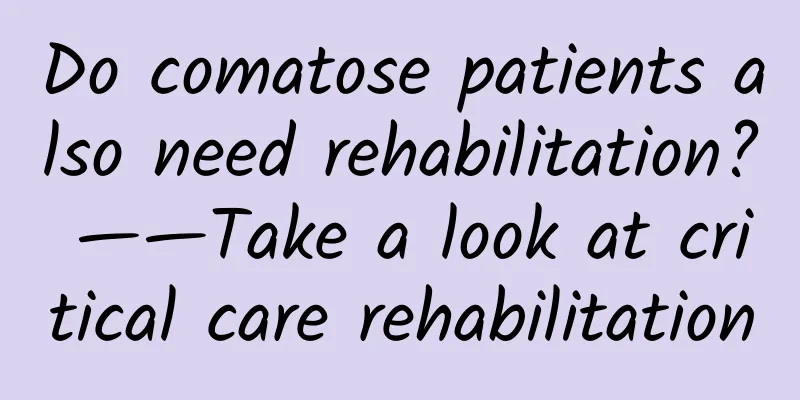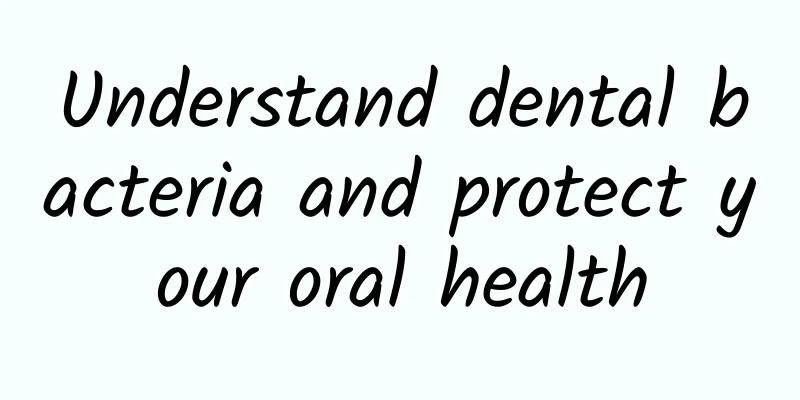Do comatose patients also need rehabilitation? ——Take a look at critical care rehabilitation

|
With the rapid development of the medical industry, rehabilitation medicine has gradually become well-known to everyone, but many people are still confused by the word "rehabilitation". The "rehabilitation" in rehabilitation medicine is different from the traditional concept of improvement and complete recovery. Rehabilitation medicine is actually a direct translation from the foreign "Rehabilitation Medicine". Nowadays, the more common meaning is a branch of medicine that focuses on the assessment of patients' functional disorders and emphasizes functional reconstruction. Rehabilitation can also be understood as the maintenance and recovery of function. Understanding this concept, it is easier to understand critical care rehabilitation. Why can patients who have entered the ICU still undergo rehabilitation? What kind of treatment is given to patients? In fact, critical care rehabilitation is a process of early functional assessment and early functional maintenance and recovery for patients who are unstable in the early stages of the disease and need to stay in bed. What is the purpose of critical care rehabilitation? In fact, the content of critical care rehabilitation is very broad, and can basically be summarized as the evaluation and rehabilitation treatment of possible complications in bedridden patients in the acute phase. Effective and timely intervention of rehabilitation technology can help patients in intensive care units reduce mortality and effectively improve their subsequent quality of life. The most common complications of critically ill patients who have been bedridden for a long time include: aspiration pneumonia, joint stiffness, reduced muscle mass, skeletal muscle atrophy, deep vein thrombosis of the lower extremities, etc. In addition, for some patients with neurological damage, coma or drowsiness is also very common, which is very unfavorable for the stability of the disease and physical recovery. Rehabilitation intervention is also based on these situations, through scientific methods and evidence-based basis to maintain the patient's existing functions and help patients recover their functions to the greatest extent. The main goals of critical care rehabilitation can be summarized as follows: 1) Reduce patients' dependence on mechanical ventilation, promote the discharge of pulmonary secretions, prevent atelectasis, and help lung re-expand, thereby improving ventilation and lung compliance and improving respiratory efficiency; 2) Promote the maximum recovery of the patient's physical function, mental and cognitive function, and transfer them out of the intensive care unit as soon as possible. Does every critically ill patient need rehabilitation? In fact, there are certain standards for what kind of patients can undergo critical rehabilitation. According to the consensus recommendations of Australian experts on safety standards for early rehabilitation of critically ill patients, the cardiovascular system, respiratory system, and nervous system need to be relatively stable for rehabilitation to be necessary and meaningful, including: 1) Cardiovascular system: systolic blood pressure 90-180 mmHg, heart rate 40-120 beats/min, no newly discovered arrhythmia and myocardial ischemia, no newly discovered unstable deep vein thrombosis and pulmonary embolism, no suspected aortic stenosis; 2) Respiratory system: Inhaled oxygen concentration ≤ 0.6, blood oxygen saturation ≥ 90%, respiratory rate ≤ 40 times/min, positive end-expiratory pressure ≤ 10 cmH2O, no ventilator-machine confrontation, no unsafe airway hazards; 3) No unstable limb or spinal fractures, no serious underlying liver and kidney diseases or progressive liver and kidney function damage, body temperature ≤38.5℃, and no active bleeding. Once these conditions are met, critical care rehabilitation can be carried out under the assessment and judgment of a clinician and the supervision of a nurse. What does critical care rehabilitation include? The intervention program for early critical care rehabilitation can be roughly divided into the following three aspects: posture management and early activity, breathing training, and muscle retraining. 1. Posture management Posture management is a technique that achieves treatment goals by changing the patient's position. For patients with respiratory diseases, the sitting position helps improve effective ventilation and facilitates the evacuation of mechanical ventilation; the prone position can be used for postural drainage, promotes sputum discharge, and reduces pulmonary edema. For critically ill neurological patients, two hours of turning over and good limb positioning are indispensable for preventing pressure sores, aspiration pneumonia, and normal recovery of later functions. This is also the important value of early activities, which also include early activities such as transfer activities on the bed, sitting up from the bed, sitting by the bed, bed-chair transfer, and standing, which can be carried out as early as the patient's physical function allows. 2. Breathing training Respiratory training includes lung recruitment therapy to help collapsed alveoli to correct hypoxemia, and chest physical therapy to help expel airway secretions. These techniques can also be performed on comatose patients, using proprioceptive stimulation techniques and recruitment techniques to improve chest expansion and help alveolar recruitment; for patients with normal consciousness, they can cooperate better, while increasing active diaphragm contraction training, increasing lung capacity, improving ventilation efficiency, promoting systemic circulation, and body recovery. For patients with pneumonia, they should be helped to learn to cough and expectorate by themselves and reduce the number of passive suction. High-frequency chest wall vibration, manual back patting, postural drainage, and active cycle of breathing technique (ACBT) can be used as early as possible and effectively. 3. Muscle strength retraining Muscle strength retraining includes peripheral skeletal muscle training and the respiratory muscle strength exercises mentioned above. Studies have shown that significant muscle atrophy will occur after three days of bed rest, and peripheral muscle atrophy not only affects the skeletal muscle system, but also aggravates the dysfunction of the cardiovascular system, respiratory system, nervous system and endocrine system, and at the same time makes it difficult to evacuate the ventilator and increases the mortality rate of critically ill patients. Therefore, peripheral muscle strength retraining is an important part of early critical care rehabilitation. Once the patient's condition allows, it should be started as soon as possible. The main method is active or assisted active movement at the bedside, and some bedside power bicycles can also be actively used when conditions permit. The popular science content of this platform has been funded by the China Association for Science and Technology's Science Popularization Department's 2022 National Science Literacy Action Project "National Society Science Popularization Capacity Improvement Project-Rehabilitation Science Popularization Service Capacity Improvement Action Plan" |
<<: A little education on cardiopulmonary exercise testing
>>: More tricks, fun rope skipping has many benefits
Recommend
These indicators on the physical examination report may be the "distress signals" sent by the kidneys!
In the fast-paced modern life, regular physical e...
What age women have the best sex life
As the saying goes: A woman is like a wolf at thi...
Can you get pregnant with endometriosis?
Getting pregnant and giving birth to a child of y...
The nine-month-old fetus kicks violently
When a pregnant woman is nine months pregnant, th...
Does hormone facial need to be eliminated?
When it comes to hormonal dermatitis, many people...
What is the difference between a small month and a big month?
The concept of confinement is very familiar to us...
How can women regulate their endocrine system?
We often see some female friends with acne all ov...
What causes brown menstrual blood?
If the menstrual blood is dark brown, then you ne...
Has Crash Landing on You been suspended? Why are episodes 7 and 8 of Crash Landing on You not updated?
Why are the seventh and eighth episodes of Crash ...
Can I keep the baby if I get pregnant with an IUD? These things need to be done well
Many women think they have an IUD for various rea...
What is the difference between Airpods Pro and Airpods 2? Who is AirPods Pro not suitable for?
After the release of Airpods Pro, many netizens w...
Pictures of Trichomonas vaginitis
Candidal vaginitis refers to a type of Trichomona...
How to cook hot pot tripe? 5 bad habits of eating hot pot are harming your health!
Author: Xue Qingxin, member of Chinese Nutrition ...
eMedCert: Data shows that the demand for health wearable products to count steps ranks first
One of the hottest areas of wearable computing de...
What to do if a pregnant woman has two plus signs in her urine protein
Pregnant women need to undergo checkups during pr...









